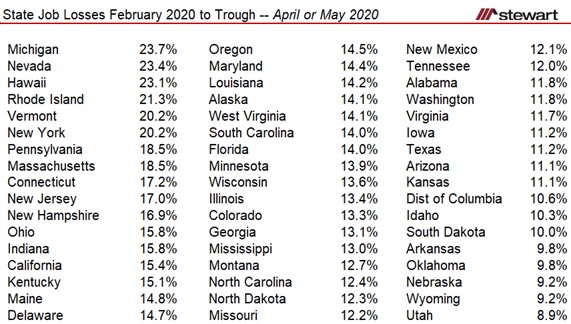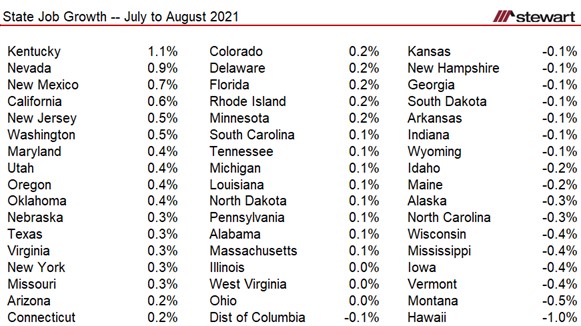Two States Down & 48 + D.C. Yet to Recover –State Employment Metrics August 2021
State employment data for August 2021 are analyzed in the following analysis. These are the latest data available from the U.S. Bureau of Labor Statistics (BLS) and are based on seasonally adjusted day allowing comparison across every month of the year.
The story remains that only two states, Idaho and Utah, had more total jobs as of August 2021 when compared to February 2020 – the month prior to the pandemic. The first table shows the percentage change in jobs comparing August 2021 to February 2020. Arizona is within a month or two or returning to pre-pandemic employment numbers (down just 0.3 percent) followed by six states less than 2 percent shy: South Dakota -1.1 percent, Montana -1.3 percent, Nebraska -1.4 percent, Texas -1.6 percent, Arkansas -1.8 percent and Tennessee -1.9 percent. Hawaii is the only state trailing pre-COVID employment numbers by double digits at 13.0 percent.

Not all states were equally impacted by COVID at the onset. The following table shows the percentage of jobs lost from February 2020 (pre-pandemic) to the trough. The employment bottom was April 2020 for all but six states -- Alaska, Hawaii, Nevada, New Mexico, Washington and Wyoming) -- along with the District of Columbia, which all hit their employment trough in May 2020.

Net one-month change in jobs from July to August 2021 are listed in the next table, sorted from best to worst.

The last table shows these metrics for all 50-states and the District of Columbia. Also include is percentage of pandemic-induced lost jobs since recovered and 12-month job gains (August 2021 compared to August 2020). In addition, total employment for each is detailed as of August 2021 expressed in thousands.

To view the vast array of employment, unemployment, income and related data available from the BLS click https://www.bls.gov/data/
Job loss and recovery dynamics continue to vary widely from one state to the next. Differing types of jobs, stimulus received, state-specific tax burdens, migration rates, COVID infection rates and local and state pandemic-related shutdowns all contribute to these metrics – along with other factors.
Jobs, however, are everything to an economy in the long run.
Ted
